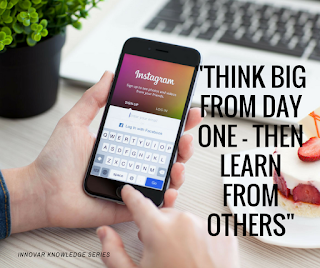Instagram and 3 not-so-simple steps to $1 billion
18 months & 3 simple, not-so-simple steps to $1 billion...
Instagram sold to Facebook for $1 billion. A week ago, when TIME asked Instagram founder, Kevin Systrom, if he would sell the company, hesaid “It’s not really on the top of our minds right now.”
Kevin is 27 years old and started Instagram 18 months ago with Mike Krieger, in October 2010. The company has grown with just 4 staff, and today has just 9 in the team. With the $1 billion deal that was announced today, was Kevin just plain lucky, or was there some simple steps that he (and others who have had the same luck) have in common?
Here’s three steps he followed. They may not guarantee you exactly the same success - but they will increase your own good fortune:
1. THINK BIG FROM DAY ONE - THEN LEARN FROM OTHERS:
It was while Kevin was studying at Stanford 7 years ago that he had the idea of a photo-sharing site, from his passion for photography. That was before iPhones, and before Facebook. Step one is to cultivate your idea by learning from others. He met Mark Zuckerberg in 2004 and talked about his idea. Mark then offered him a job at Facebook, which had just launched (in hindsight, a cheaper option that the $1 billion he’s just paid to work with Kevin). Kevin turned him down but they stayed in touch. He went to intern at Odeo with Evan Williams, who sold Blogger and Jack Dorsey, who launched Twitter. This is where Kevin got to understand the power of social sharing. Kevin later said “Comparing Instagram to photography is like comparing Twitter to Microsoft Word”.
He then went on to work at Google. All in all, it was a full six years after having the idea of a photo sharing site that he worked with others leading the field: Getting paid for his own education before he launched his own start-up. As Kevin says, “I was given the opportunity to be in the middle of a ton of
innovation, and meet some of the smartest people doing the coolest stuff inthe world. When I finally did it [myself], it just felt so right.
"Who could you (and should you) be working with today to lay your own foundation?
2. KEEP 100% FOCUSED ON WHAT PROBLEM YOU’RE SOLVING - AND FAIL FIRST:
When Kevin launched Instagram in October 2010, he explained in his first blog what problems Instagram intended to solve. He listed the top three problems users were having:
“My mobile photos look lame.”
“It’s a pain to share to all my friends.”
“Photos take forever to upload.”
How would he know these were the problems? Just by talking to people? No, by getting it wrong the first time. In early 2010 he launched his first attempt “Burbn” as a location-based photo app, using Foursquare. It was a one-manband, but after a year of hard work it had failed to catch on. It was, however, a failure that allowed him to learn from his users what would work, and to
attract interest from like-minded people, including his future co-founder of Instagram, Mike Krieger.
By focusing on these three problems, Instagram launched in October 2010. Kevin relates the first moments of launch: “It was 12:15am, October 6th and we had been working on the app non-stop, day and night for 8 weeks. With a bit of hesitation, I clicked the button that launched “Instagram” live to the Apple app store. We figured we’d have at least 6 hours before anyone discovered the app so we could grab some shut-eye. No problem, we figured. Within a few minutes, they started pouring in... The night of sleep we were hoping for turned into a few meager hours before we rushed into the
office to add capacity to the service. Now, only a couple months later, we’re happy to announce that our community consists of more than a million registered users.”
What problem are you solving, and what are you learning by failing, that is setting you up for your own overnight success?
3. CUT OUT ALL THE NOISE:
Kevin explains the difference between Instagram and Burbn: “We actually got an entire version of Burbn done as an iPhone app, but it felt cluttered, and overrun with features. It was really difficult to decide to start from scratch, but we went out on a limb, and basically cut everything in the Burbn app except for its photo, comment, and like capabilities. What remained was Instagram.”
Kevin cut out all the noise. He then launched Instagram just on the Apple App Store (It just came to Android last week) and focused on sharing on Twitter and Facebook (Three platforms that didn’t even exist when he first had the idea). That’s it: Photo, comment, like. No other platforms. No other noise.
Simpler means sharper means easier to cut through the noise. Instagram went from one million users by Dec 2010 to 30 million users today. In 2011, Apple named Instagram the “App of the Year”. Why would Facebook buy inow for $1 billion? Because Mark already knows it will add more value than
that to Facebook when it has its upcoming $100 billion IPO.
If you are already thinking big, connecting smart and focused at the problems you are solving - How could you solve them in the fewest number of steps?
Source: Entrepreneur Inspiration




Comments
Post a Comment